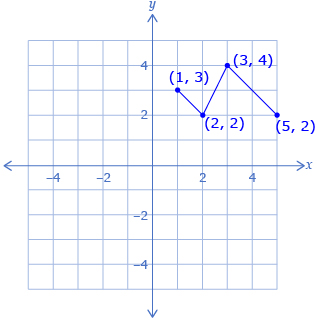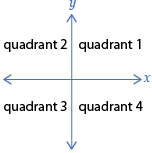Discover
Try This 1
On a piece of graph paper, plot the points (1, 3), (2, 2), (3, 4), and (5, 2) as shown in the diagram.

- Imagine using the y-axis as a line of reflection, or a line of symmetry, to reflect the points across the y-axis. Sketch the new image on your graph.
- Reflect your original points across the x-axis and sketch the new image.
- Use the diagrams you created to complete a table like the following.
Coordinates of Original Point
Coordinates After Reflecting Across the y-axis
Coordinates After Reflecting Across the x-axis
(1, 3)
(2, 2)
(3, 4)
(5, 2)
- What relationship do you notice between an original point and that point reflected across the
- y-axis?
- x-axis?
- Was the original figure a function? Are the reflected figures functions?
- Use Reflection Interactive to check your table from question 3.

- The original relation had all points located in the first quadrant. Drag each point of the blue figure so the figure has points in multiple quadrants. Use Reflection Interactive to repeat questions 1 to 5.

![]() Save your responses in your course folder.
Save your responses in your course folder.
Share 1
With a partner or group, discuss the following questions based on the information from Try This 1.
- Did you find the same relationship in question 4?
- Did reflecting a function create a function? Will this always be true? Explain.
- If you reflected a relation that was not a function, would the reflection create a relation that is not a function?
